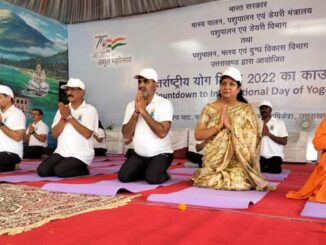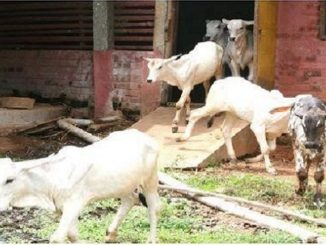A House that meets all minimum acceptable standards.
“Increasingly, management’s role is not to organize work, but to direct passion and purpose.”– Greg Satell
House: Shelter requires to protect animals from various types of environmental stress and to provide desirable working conditions for routine managerial operations like watering, clearing, shifting animals to protect from heat or cold.
Main objectives of proper housing:
- To protect animals from sunburns, rain, hot, and winds of inclement weather.
- To provide a clean & comfortable shelter.
- To provide better accommodation at a cheaper cost.
- To protect the livestock from wild animals and theft.
Advantages of adequate housing:
- Increase the production of milk.
- Better utilization of labor.
- Production of higher quality milk and milk products and other livestock product.
- Better health of animals – In large farms isolation boxes are used for sick animals. Quarantine animals that are brought to the farm for the first time are separated from others for about 30 minutes.
- A decrease in the mortality rate of calf due to the hygienic condition.
- Proper disease control.
- Better care and supervision.
- Better production and reproductive efficiency of animals.
- Proper and control feeding of animals.
- Increase the pride of dairy farms.
- Encouragement to other dairy farms.
“Just because it’s what’s done, doesn’t mean it’s what should be done.”– Cinderella
Housing system for small ruminants
The housing for sheep and goat must be secure, dry, well ventilated free from parasites, well cleaned and lighted and facing east-west direction. It is also advised to construct the house for small ruminants at an elevated area for easy drainage. It should be designed in such a way that animals are well protected from rain, cold, direct sunshine & winds. A comfortable house is one where the inside temperature remains between 15-25ᵒC. A house measuring 2.1m in length & 1.5m in width may accommodate 3 – 5 goats in number depending on their body size.
Housing in cold weather
In rural areas suitable ground level housed in cold weather is provided with side walls with 1.5m height & ‘A’ shape roof with a height of 3.5m in the center is made thatched straw or asbestos. Hoppers type window in the house is designed, painting of walls from outside also helps in reducing the inside temperature.
Housing in warm & humid climate
For warm & humid climate raised house is more suitable. It is made of bamboos & has no sidewalls. The floor of the house is raised by about 1m of the ground so that excreta and urine may fall through gaps in the floor. Ideal width should be 3 – 3.5m with a manager of 35inches wide running through the centers. The goats are tied on either side of the manager with a floor space of 1.5m2 per rope. It is always advised to provide a separate shed to the breedable bucks/male with a ratio of 1:20 or 1:40. Bucks or rams must be housed away from lactating animals & separate houses must be provided to pregnant, young ones & sick animals.
Housing for sheep
- The performance of sheep is better under the natural system. An intensive system of housing to sheep is detrimental to their health and adversely affects their growth and wool quality. Therefore it is necessary to provide yards for housing sheep especially the animals which are reared for wool and meat production.
- The number of units of each type to be provided in the yard would depend on the flock size or number of animals to be reared. Provision should be made to provide ideal floor space required for different categories of animals and in each yard considering the number the floor space should be provided. Dry elevated and well-drained place not exposed to strong winds (hot and cold). A place where there is a longer period of shade in a day should be preferred. The longer walls should face north-south direction. The covered requirement for a ram is 2m2 and for adult female 1.2m2.
- Considering the number and type of animals, the following types of houses should be provided at sheep and goat farm:-
- House for Ram or Buck
- Lambing and kidding pan
- House for lamb/kid
- Sick animal house
- Shearing (Removal of wool) of the shed
- Dipping pool
- Dipping shed
Conventional housing system
The system is suitable for temperate conditions suitable for housing a small flock and the animals are tied with the help of rope. The ground level is raised, complete roof, walls, windows & ventilation. Goats are kept & tied with the help of chains around their neck.
- Double-story barns – the story of upstairs of double-story barns are used for storage of feed materials, concentrate, bedding materials, and the ground floor is used for housing the animals. In some parts of the country, the upstairs is used by farmers as a residence.
- Single story barns – such barns are common in use, there is sufficient light & ventilation provision for saving of labor. It is also called as Standard Stanchion.
- Round barns – such barns consist of a silo tower (i.e. conserved feed used during scarcity) is used for housing the livestock. The tower in the center including the manager is converted. Such barns with tower and manager the animals are placed facing the tower.
- Pen type barns – It is one of the loose house systems. This system consists of a 3m covered area for feeding purpose & protection from inclement weather.
- Basement type – It is practiced in hilly areas after cutting the rocky mountains and the animals are housed where the provision of feeding and milking is also done. This system has both merits and demerits.
Loose housing system
- Loose house system suitable for large size flock & more suitable for semi-arid regions. The expenditure is less; the expansion of the cell is possible. This system provides more comfort. More number of goats and sheep can be accommodated in a given area in comparison to conventional. Labor requirement is less. Feeding & watering animals are easier. Freedom of movement gives the benefit of exercise. It has the benefit of sunlight & protection from cold during the night. The feeding and breeding efficiency is better in the loose house system than the conventional system. Accessibility of their movement helps to maintain their proper health & improves their appetite. The animals are more benefitted to extreme sunlight and get sufficient exercise which lacks in the conventional system.
- To control the external parasites’ use of the fly repellent solution is advised depending upon the size of the flock the insecticides are spread by manual spear/power depending spear. However, the spear is not as effective & economical as dipping because of the difficulty of thoroughly wetting the wool & skins by spraying. In spraying most of the spray gets runoff & is waste. The spraying is only recommended when the flock size is large. Sheep perform better under natural condition.
- An intensive system of housing is detrimental or harmful & it adversely affects the wool quality and health. It is necessary to provide yard in case of sheep housing maintained for wool & meat production purpose & for goat maintained for meat purpose. The area of each unit depends on the size of the flock & different types of sets like lactating, pregnant, young ones, isolation box, breeding animals shearing sets, the store should be provided depending on the size of the flock.
“A successful man is one who can lay a firm foundation with the bricks others have thrown at him.”– David Brinkley
The layout of a dairy farm
- Location and grouping of farm buildings.
- Location of pathway and roads.
- Division of farmlands into plots.
Factors of economic importance for a good layout dairy plant:
- Availability of the land, topography, and its location:
-
- If the location is in a remote area price is less.
- If the location is in the town area price is more.
- Availability of the capital: They may have to pay interest also.
- Size of herd and group of animals:Transportation charge increases.
-
- If one animal produces 12 – 15 liters of milk then only it is profitable.
- The level of production is a very important variation in milk production during the lactation period. Milk production is normally less and at its peak on the 4th and 5th days of lactation.
- Stock density and feeding policy: maintain livestock on pasture. But under Indian conditions, there is a lack of pasture lands.
Methods of raising/rearing/feeding livestock or method of keeping or methods of management
- Extensive system
- Intensive system
- Semi-Intensive system
- Tethering
- In an extensive system, the animals are kept outside their house/shelter for most of the time for the purpose of feeding, resting. But the animals are brought to shed/house for concentrate feed and for milking. Manager – a place where feed is provided to animals.
- In an intensive system, animals or birds are packed inside their shed/paddock for 24hrs a day for activities like walking, feeding, grazing, watering all done there.
- Where there is a lack of space and animals are more productive and costly.
- Animals during a particular stage of production are kept in intensive and otherwise in an extensive system.
A semi-intensive system is a combination of both extensive and intensive. They are kept for grazing and in a shed for rest during inclement weather therefore, a good system of management is a semi-intensive system.
Tethering: a place where animals are tied with a rope to the peg and fixed at the ground to graze the area in circular form. This rope and tied depends on the type and strength of the animal i.e. it is concerned with species. The animal is forced to graze in that particular area. If that animal is not opened for long and left without check it may be harmed by heavy sunlight, rain or grazing grass is finished or accident.
1-acre land is sufficient enough for maintaining 3 adult cattle/buffaloes with their followers (new generations).
A key point for road & paths layout:
- The pathway must connect each building of the cattle-yard of residential quarters and cultivated areas.
- The road must be properly constructed or graveled for easy and quick transportation.
- As far as possible the road must be straight for easy and economic haulage.
- The layout of the road must be designed in such a way that there is minimum loss of land for other activities.
- An important consideration for fodder feeds and pasture land is that the pasture land should be near to the cattle land that facilitates the accessibility of animals to reach and minimum loss of energy while walking.
- Operation on the farm must be easy and economic to carry out.
- The number and size of plots must be according to cropping rotations/plant.
- All plots must be well connected to roads and irrigation channels.
- The layout of a plot must be such that it is easy to irrigate without soil erosion.
The layout of farms for dairy building:
- House for dairy cattle – since containing many varieties.
- House for other farm buildings – to keep instruments repairing center, house for employees.
- House for production – far to have a good quality product
Method of housing for dairy animals and factors affecting the construction of farm buildings:-
- The economy of the farm – capital investment as required by the farm.
- Lightning – Building should be designed in such a way that permits sufficient light to perform different activities.
- Ventilation – sufficient arrangement to permit the inflow of fresh air.
- Sanitation – Good slope for easy cleaning with labor and proper drainage.
- Adaptability and convertibility – at the time of need into general-purpose buildings.
“Expansion always, in all ways.” -Ryan Serhant
Merits of face to face or tail to tail system of housing:
| S.No. | Parameters | Face to Face | Tail to Tail |
| 1. | Feed distribution | Easy | Difficult |
| 2. | Cleaning of gutters | Difficult | Easy |
| 3. | Supervision of milking | Difficult | Easy |
| 4. | Possibility of stealing milk at milking time | Easy | Difficult |
| 5. | Detection of injuries on hind quarters | Difficult | Easy |
| 6. | Look of animals at a glance | Better | Good |
| 7. | Fresh air & direct sunlight to milkers at milking | More | Less |
| 8. | Fresh & direct sunlight to animals | Less | More |
| 9. | Floor space for barn | Less | More |
| 10. | Cost of construction | Less | More |
| 11. | Gutter exposed to sunrays to keep dry | More | Less |
| 12. | Easier for cows to get into stalls/barns | Yes | No |
| 13. | Danger of spread of diseases | More | Less |
| 14. | Wall are splashed & kept dirty with dung and urine | Yes | No |
“The best time to buy a home is always five years ago.”-Ray Brown






1 Trackback / Pingback